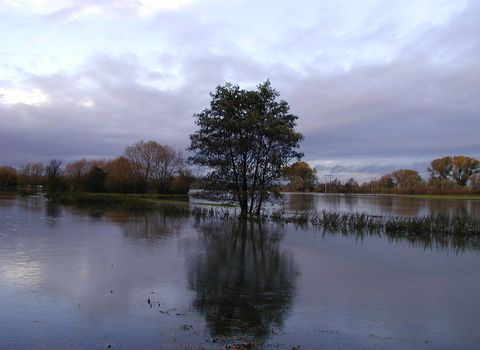What is Natural Flood Management?
Natural flood management means allowing or restoring rivers or landscapes to function more naturally with the result that the flow of water into rivers is slowed, the flow within rivers is slowed, and the landscape generally holds more water. The objective is to limit the amount, and speed, of water within river channels which minimises flooding.
Natural flood management has multiple benefits for both people and wildlife. Examples include: leaky dams, cross-slope hedgerows, riverside woodland attenuation ponds and scrapes
Where are we working?
The Wye Adapt to Climate Change project, begun in 2023, is a partnership between the Wye Valley Area of Outstanding Natural Beauty (AONB) Partnership, Radnorshire Wildlife Trust and Herefordshire Wildlife Trust, funded by the National Lottery Community Fund's Climate Action Fund. The project will promote the creation of community climate action networks to support local communities in making positive changes to adapt to the effects of a changing climate. Project staff will also work with landowners to explore nature-based solutions to impacts from climate change such as holding water in the landscape to use for irrigation of agricultural land and prevent flooding of housing and businesses.
In the Upper Lugg Catchment, on the Lingen and Lime Brooks, we’re working with landowners to implement sustainable practices to reduce river pollution from excess nutrients and soil run-off as well as improving riverside habitats, increasing wildlife connectivity through the landscape and carrying out work to help river wildlife better adapt to climate change.
This year also sees the start of Wyescapes; Food, Nature, Water, a Landscape Recovery partnership between Herefordshire Rural Hub, the Wye Valley AONB Partnership, Herefordshire Wildlife Trust and the Wye and Usk Foundation and will involve an initial groups of 36 farmers. The project’s aim is to restore the Wye catchment to a healthy condition, so its rivers and their tributaries can support the unique wildlife that depends on them, provide clean and plentiful water, be resilient to climate change, mitigate flood risk, enable sustainable farming and provide places for people to enjoy.
In the Lower Lugg Valley, we’ve supported one landowner to create a suite of ‘attenuation ponds’ alongside a brook. These now help to hold water in the landscape upstream of the village, helping to lessen flood risk to houses. The ponds were fully tested last week and they filled quickly and held water - with no reports of properties being flooded downstream.
All these projects will take time to come to fruition and it's important we continue to work across whole catchments, joining up all the positive work, so each mitigation has the greatest effect.
More information about Natural Flood Management and our projects can be found at: https://www.herefordshirewt.org/our-river-recovery-work
For advice on land management for climate mitigation and biodiversity, please contact our consultancy team: consultancy@herefordshirewt.co.uk

